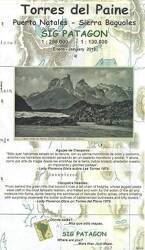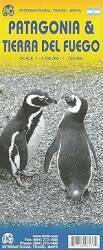
Salto Grande
Day Three — Salto Grande and the Trail to Mirador Cuernos
My third day at Torres del Paine wasn't as dramatically
sunlit as the second day,
but the winds weren't as bad and the trail was open
from Salto Grande to Mirador Cuernos,
a lookout point at Lago Nordenskjöld.
The ranger recognized me when I arrived at the entry gate,
and he immediately asked me if I had been to Salto Grande.
I said no, not yet, but that was my plan for the day.
He nodded approvingly.
Salto Grande or "Big Leap"
is a waterfall draining Lago Nordenskjöld
into Lago Pehoe.
Mirador means "viewpoint",
Mirador Cuernos overlooks
Lago Nordenskjöld
across from Cuernos del Paine.
The Waterfall
Even with the sky mostly clouds, the water glowed with a turquoise shade because of the glacial flour, the mineral powder ground off bedrock by glaciers and suspended in the water.

Cerro Paine Grande, with peaks at 3050, 2750, 2730, and 2600 meters, is nearby. Its peaks were always well into the cloud base throughout my four-day visit to the park.

Looking downstream, Salto Grande empties Lago Nordenskjöld into Lago Pehoe. That connects through Rio Paine to Lago Toro, which eventually connects into the Última Experanza Sound, which passes Puerto Natales and thus eventually connects to the Pacific Ocean.


Looking upstream from the waterfall, it was a short distance to the southwest end of Lago Nordenskjöld.

The Trail to Mirador Cuernos
A trail leads off the wooden overlook above the waterfall, headed toward Mirador Cuernos.

CONAF, the Chilean national park governing body, has a signpost depicting and describing the trail. It's five kilometers to the far end and back. It's an easy walk as you only gain about fifty meters elevation.

The first two-thirds of the trail is almost level, staying close to the shoreline.



Condors were soaring in the updrafts around Cuernos del Paine.
The Andean condor is the officially recognized national bird of Bolivia, Chile, Colombia, and Ecuador. It has appeared in Andean art since around 2500 BCE and it plays a prominent role in the region's folklore and mythology. The Andean condor was associated with the sun deity and was believed to be the ruler of the upper world in Andean myths and religions.

The Andean condor, with a wingspan up to 3.3 meters and weight up to 15 kilograms, is now the world's heaviest flying animal and the largest bird of prey.
Adult condors are all black except for a frill of white feathers at the neck and, especially in males, broad white bands on the wings.
The Andean condor feeds on carrion, preferring large carcasses. It prefers relatively open areas which allow it to spot carrion from the air. In southern Patagonia, the open meadows have always been home to guanaco. European settlers arrived with sheep. The condors eat dead guanaco and sheep along with smaller carrion. Nearby peaks provide cliffs for nesting.
Updrafts caused by the strong winds channeled around and over the mountains allow the condors to mostly soar once they get off the ground. In his book The Voyage of the Beagle, Charles Darwin described watching condors fly for half an hour without a single flap of their wings.

Condors mature slowly and adult condors have no natural predators. We know that the Andean condor is a long-lived bird, but the details have not been extensively studied in the wild.
However, a male Andean condor born in captivity in 1930 died in January 2010 at the Beardsley Zoo in Connecticut, USA. His death at 79 years of age gave him the greatest verified age ever known for a bird.

Ice high on Cuernos del Paine showed the paine, the light blue color for which the park is named.

Lago Nordenskjöld is even more paine.

The above picture shows Cuernos del Paine. Below is the view into Valle del Francés just right of center, with Cerro Paine Grande to its left.

Zooming in shows more detail in Valle del Francés. This had been the source of the previous day's sustained wind above 80 km/h, which had led the rangers to close this area.


I had reached El Fin del Sendero, the End of the Trail.

It's a good vantage point to watch the clouds move through the peaks.


I would return for one more day in the park. On my way into the park, I had a great view of an iconic series of peaks, the only time they weren't covered by clouds during my visit.


The pterosaurs, even larger flying animals, died off about 66 million years ago at the end of the Cretaceous period. That was when an asteroid about 10 kilometers in diameter struck what today is the shoreline of the Yucatán peninsula, causing the K-T extinction event that killed three-quarters of the plant and animal species on Earth.